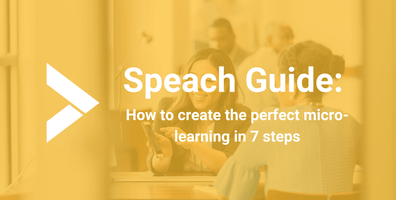Maximizing learning transfer is a critical goal for any educational or training program. Learning transfer refers to the application of skills, knowledge, and abilities learned in one context to another context. To achieve this, it’s essential to use strategies that reinforce and consolidate learning. Microlearning, characterized by delivering content in small, focused segments, is an effective tool for this purpose. In this blog post, we will explore how microlearning can be used before and after a learning event to support recall and transfer, drawing on data and neuroscience studies that highlight the importance of repetition in knowledge retention.
The Role of Microlearning in Learning Transfer
Microlearning involves breaking down complex information into bite-sized, easily digestible chunks. This approach aligns well with the way our brains process and store information. By presenting information in smaller segments, learners are less likely to experience cognitive overload, making it easier to understand and retain new information.
Before the Learning Event: Preparing the Mind
- Priming the Brain: Before the main learning event, microlearning modules can be used to prime the brain. Priming involves exposing learners to concepts and terms that will be covered in more detail during the main event. This pre-exposure helps create a mental framework for the new information, making it easier to absorb and integrate.
- Building a Foundation: Microlearning can introduce foundational concepts and terminology. This preparatory phase ensures that learners have the necessary background knowledge, which can significantly enhance their understanding and retention during the main learning event.
- Reducing Anxiety: By familiarizing learners with the content beforehand, microlearning can reduce anxiety and build confidence. When learners feel prepared, they are more likely to engage actively during the learning event.
After the Learning Event: Reinforcing and Retaining Knowledge
- Spaced Repetition: One of the most well-supported strategies in neuroscience for enhancing memory is spaced repetition. This involves reviewing information at increasing intervals over time. Microlearning is ideal for spaced repetition because it allows learners to revisit and review content in short, manageable sessions. According to a study published in Psychological Science, spaced repetition significantly enhances long-term retention of information.
- Immediate Reinforcement: Immediately following a learning event, microlearning can be used to reinforce key concepts. This immediate reinforcement helps consolidate new information in long-term memory. A study by the Journal of Applied Psychology found that immediate review of learned material greatly improves retention and recall.
- Application and Practice: Microlearning modules can provide opportunities for learners to apply what they have learned in practical scenarios. These modules can include quizzes, case studies, and interactive simulations. According to research from the Cognitive Load Theory, applying knowledge in different contexts enhances transfer and retention by reducing cognitive load and making learning more meaningful.
Neuroscience and the Importance of Repetition
Repetition is a cornerstone of effective learning. Neuroscientific research has shown that repetition strengthens neural connections, making it easier to retrieve information when needed. The process of long-term potentiation (LTP), which strengthens synapses based on recent patterns of activity, is fundamental to learning and memory.
Data Supporting Microlearning and Repetition
- Ebbinghaus’ Forgetting Curve: Hermann Ebbinghaus, a pioneer in the study of memory, developed the forgetting curve, which shows how information is lost over time when there is no attempt to retain it. Regular review sessions, as facilitated by microlearning, can help flatten this curve, ensuring that information is retained over the long term.
- Research by Harvard University: A study conducted by Harvard University found that students who engaged in microlearning before and after lectures had significantly higher retention rates compared to those who only attended lectures. The study concluded that the frequent, spaced repetition of key concepts played a critical role in enhancing memory retention.
- Corporate Training Success: In the corporate world, companies like IBM and Google have reported success using microlearning. IBM found that employees who participated in microlearning sessions showed a 20% increase in knowledge retention and a 10% increase in application of skills on the job.
Practical Steps to Implement Microlearning for Learning Transfer
- Identify Key Concepts: Determine the core concepts that need to be reinforced and create microlearning modules focused on these areas.
- Schedule Regular Reviews: Implement a schedule for spaced repetition, ensuring that learners review key concepts at regular intervals.
- Use Varied Formats: Mix different formats such as videos, quizzes, and interactive scenarios to keep learners engaged and cater to different learning styles.
- Provide Immediate Feedback: Incorporate quizzes and assessments that provide immediate feedback to reinforce learning and correct misunderstandings.
- Encourage Application: Design microlearning activities that encourage learners to apply their knowledge in real-world scenarios. This could include case studies, simulations, or problem-solving exercises.
- Monitor and Adjust: Use analytics to track learner progress and adjust the microlearning modules as needed to address any gaps in knowledge or understanding.
Conclusion
Microlearning is a powerful tool for maximizing learning transfer. By strategically using microlearning before and after a learning event, educators and trainers can enhance recall and ensure that knowledge is retained and applied effectively. The combination of neuroscience-backed repetition strategies and practical, engaging content makes microlearning an invaluable component of any effective training program. By leveraging the benefits of microlearning, organizations can create a more dynamic and effective learning environment that fosters continuous growth and development.





